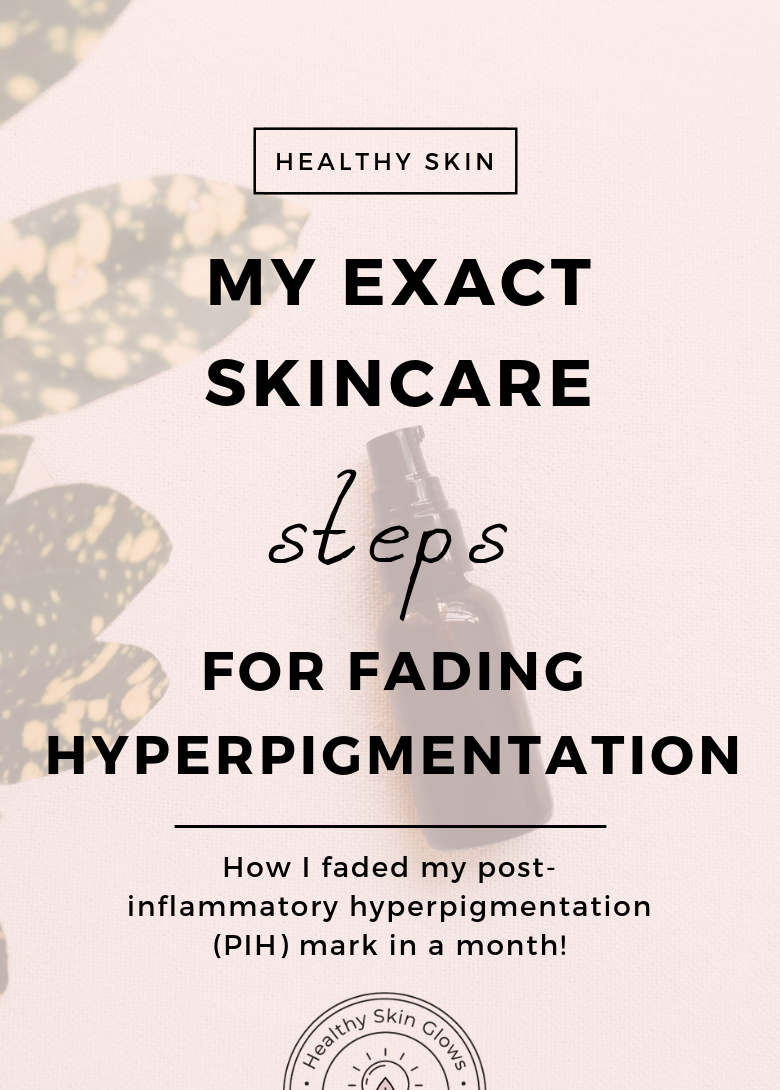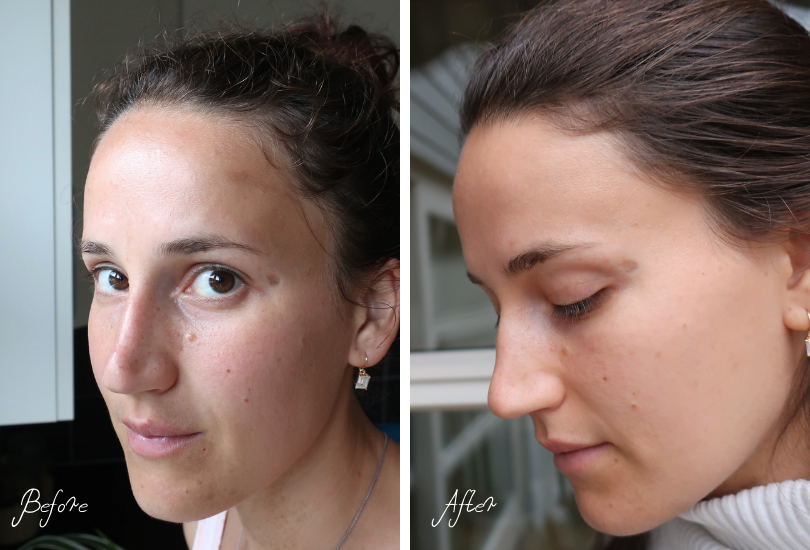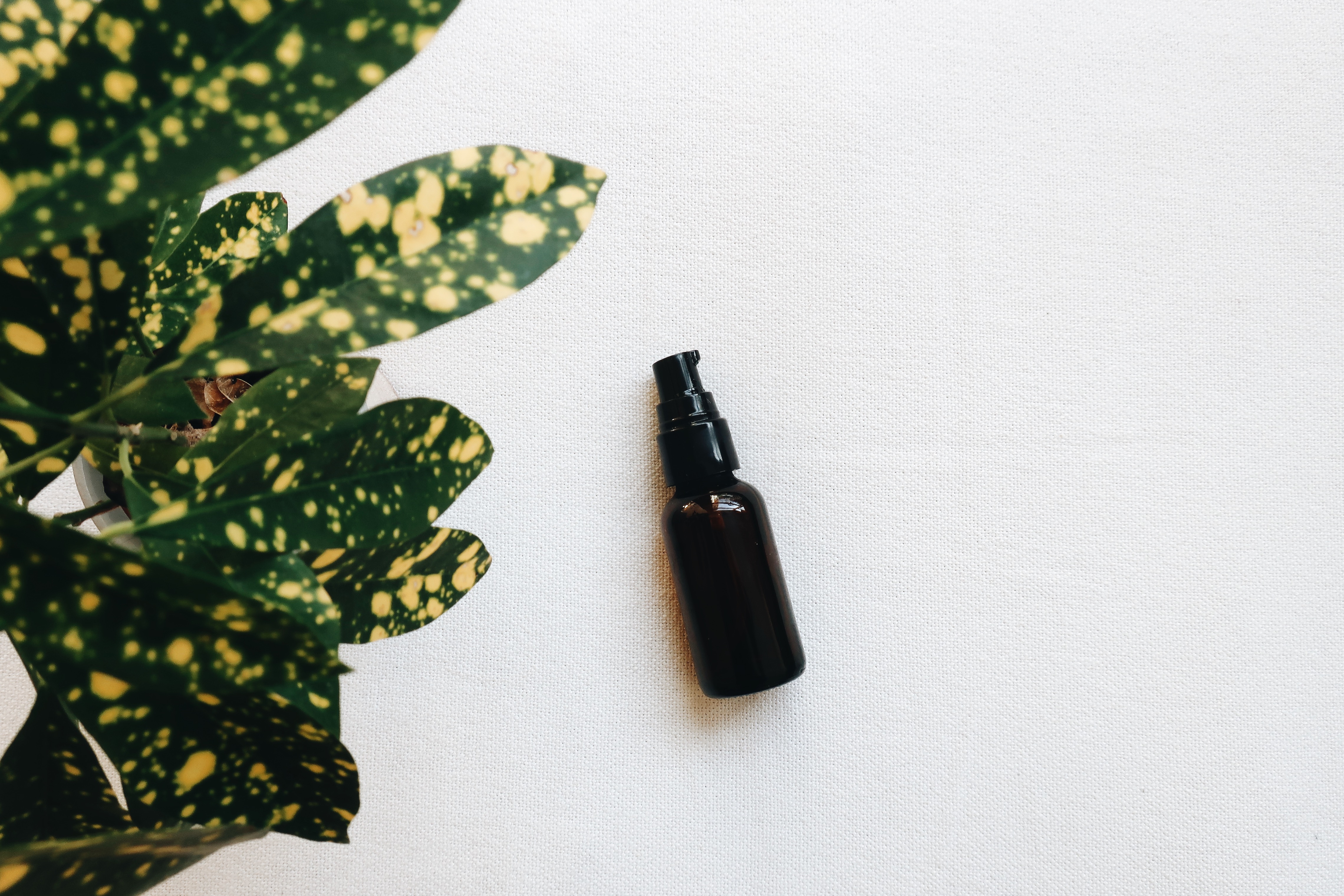
Before we even start discussing how to fade hyperpigmentation, it is very important to understand what is actually causing it in the first place!
Back in the day, my acne would always leave brownish marks behind. The correct term is post-inflammatory hyperpigmentation (PIH).
It would often take months to fade them, and by that time, there would be new ones to deal with!
Last summer, I made the mistake of touching my face right after squeezing lime juice into my morning water.
Sure enough, subsequent exposure to the sun left me with a hyperpigmentation streak on my forehead!

Why did this happen?
Fresh lemon and lime juice are photo-toxic due to the substances they contain, such as furocoumarins. There are also other potentially irritating substances, such as limonene and citral.
So, it isn't just acne that can cause PIH, but also irritating substances, oxidative damage and anything that raises inflammation in your skin.
Irritation -> inflammation -> hyperpigmentation!
Hyperpigmentation happens due to localized bursts of melanin production, triggered by an inflammatory event. Melanin is the pigment that gives your skin color (tan). Its function is to protect your skin from UV rays (which bring oxidative damage and hence inflammation).
To successfully fade hyperpigmentaion, you also need to eliminate sources of irritation and inflammation. Give this post a read if you haven't already:
Related: 8 Golden Rules For Preventing Hyperpigmentation
In this post, I walk you through how I completely faded my hyperpigmentation mark within a month, and how you can apply my strategies to reduce your PIH faster.
WHAT WORKED, WHAT DIDN'T
I don't ever change my skincare routine dramatically, it's always pretty much the same. All I was trying to do was introduce one product at a time that had the ability to fade PIH.
Some worked, some didn't.
It doesn't mean that ingredients that didn't work for me won't work for you.
Substances that inhibit tyrosinase, an enzyme essential for melanin production, are usually helpful in reducing PIH.
So, for several weeks I have tried arbutin, exfoliating products, vitamin C serum, and my hyperpigmentation mark was NOT moving at all.
Don't get me wrong, I know that PIH can take many months to fade, but I had a feeling that this mark was not as deep as those left after acne and that it should go away quicker.
Then I started doing the routine outlined below, and I kid you not, the hyperpigmentation mark started fading within days!
Even though the hyperpigmentation patch I had was likely easier to fade than the usual acne induced PIH spots, I believe you can apply the same strategies (if your skin accepts these ingredients well) to get good results.
Just remember to be patient!
Another important thing you must ensure is that your entire skincare routine respects what I call the Healthy Trio: Skin barrier, acid mantle and skin microbiome.
If your skin is unhealthy, it won't be able to heal any kind of acne scars efficiently!
To evaluate your skincare routine, learn more about the Healthy Trio, and get tips on how to start healing adult acne, take my FREE online course.

MY EVENING SKINCARE ROUTINE FOR FADING HYPERPIGMENTATION (PIH)
1. Cleanse my face – This is most often simple oil cleansing with argan oil or using a gentle cleanser.
Related: Simple Oil Cleansing Method (Step-By-Step Guide)
2. Apply a toner or a gentle retinoid
I love DIY chamomile tea toner, rose water toner and I also used vitamin A serum by Mad Hippie for this step.
3. Apply my DIY face oil blend
This one was the KEY to my success! My hyperpigmentation started fading within days when I started with this oil blend.

I applied about 4-5 drops of this oil on my entire face, gently massaging, but you can also just apply it where you have PIH spots.
DIY oil serum for reducing hyperpigmentation
This wonderful oil blend has been made in collaboration with Tracy Tighe.
- 2/3 rosehip oil
- 1/3 argan oil (or another more nourishing oil of your choice)
- 5% of total essential oils, here we use two that work synergistically to reduce hyperpigmentation: frankincense and copaiba (see details below)
To make a 15ml oil blend, follow this recipe:
- 10mL or rosehip (2 tsp)
- 5mL of argan (1 tsp)
- 11 drops of each essential oils (for 5% concentration). To start with, I recommend doing the 3% concentration, which is ~6 drops of each essential oil
Roll the bottle between your fingers (don't shake vigorously!) to blend the oils, and leave overnight in a cool and dark place. I stored my bottle in the fridge.
KEY NATURAL INGREDIENTS THAT FADED MY HYPERPIGMENTATION
Rosehip oil
Rosehip oil is very rich in an essential fatty acid called linoleic acid, which can be very healing for acne-prone skin.
Furthermore, it is rich in antioxidants such as lycopene, lutein, rubixanthin, xanthophyll and zeaxanthin (carotenoids), catechins and flavonoids such as quercetin, which lower inflammation. Quercetin can also inhibit the activity of the enzyme responsible for the breakdown of elastin in our skin.
It's these antioxidants that give this wonderful oil its orangey colour. The more intense the colour the higher the antioxidant content!

What's also very exciting about rosehip oil is all-trans-retinoic acid (tretinoin), found in small amounts in it.
It's because of the retinoic acid that rosehip oil acts as a natural retinoid, helping you increase cellular turnover (along with other benefits). Yes, this molecule is the same one as in prescription retinoids (tretinoin), but there is a far lower concentration of it in rosehip oil.
So far, it has been shown to be safe to use during pregnancy and breastfeeding (unlike prescription retinoids!)
Just how much retinoic acid the oil contains depends on the soil where the rosehips were grown (and other conditions), whether it was cold-pressed, organic, etc.
Always aim for cold-pressed, organic rosehip oil from a reputable company.
Anything else probably won't be effective!
Even different batches of rosehip oil from the same company might differ somewhat.
Argan oil
While I wanted to have rosehip seed oil in my DIY serum for obvious reasons, using it on its own can actually be a bit drying for the skin after a while.
Cue in the argan oil!
Argan oil is one of the most nourishing oils and very rich in vitamin E. Vitamin E is natural to our skin, acting as an antioxidant and protecting the sebum from oxidizing. It also helps the oil blend stay fresh for longer.
However, so much of the argan oil on the market is simply rancid (bad smell gives it away), so I can't recommend anything on the international market.
You can try looking for a high-quality, cold-pressed and organic argan oil (cheap ones are probably bad!), or substitute it for another more nourishing oil in your DIY oil blend. Even jojoba oil can be a good choice.
Frankincense essential oil
Now for another star ingredient of this DIY oil blend!
For decades, this wonderful essential oil has been used in skincare and for various other ailments, but scientific research has been very scarce.
I have been in the science world for long enough to know that this kind of “anecdotal evidence” usually has some truth to it, and the science just needs to catch up.
In 2017, a study revealed indeed that frankincense essential oil (FREO) “affected many important signaling pathways that are closely related to inflammation, immune response, and tissue remodeling”.
This study provides the first evidence of the biological activities of FREO in human dermal fibroblasts, showing FREO was able to significantly alter the gene expression that affected the inflammation levels and immune response.
As we have already learned, regulating the inflammation levels is the key to reducing and preventing hyperpigmentation!
Copaiba essential oil
Copaiba essential oil might be less known than frankincense, but it is also highly anti-inflammatory, and can help other oils penetrate better into the skin!
It is in fact so anti-inflammatory and anti-septic that it has shown good results in treatment of acne in this study, too. The concentration used was just 1%.
In conclusion, if your skin can tolerate essential oils, it might definitely be worth trying out copaiba essential oil!
FINAL THOUGHTS (PROCEED WITH CAUTION)
There are a few things you must keep in mind when using the DIY oil blend:
- Not everyone can tolerate oils, and if that's you (for example, your skin reacted badly to
an oil in the past), don't use them - Not everyone can tolerate essential oils (because they are very powerful and can be irritating), so if you have had an issue with them in the past, don't use them
Furthermore, applying products that contain some kind of retinoid on an exfoliated face can be irritating, which is why I must urge you to proceed with caution if you are using rosehip oil or other retinoids after an exfoliating mask (including a clay mask).
Start by introducing one product at a time into your routine and give your skin 2 weeks to adjust before moving onto the next one.
If you do this, also note that your skin might not be able to tolerate the
If you are someone who cannot tolerate any oils in skincare, respect the signals your skin is giving you and don't use them.
Furthermore, I also wouldn't use essential oils on your skin for prolonged periods of time, just until you accomplish your goal (fading hyperpigmentation in this case). This is because essential oils have anti bacterial properties and can therefore cause an imbalance in your skin microbiome if used for too long.
In my Skin Rebalancing Protocol, I give you the exact skincare routine to follow based on your skin type and skin condition (without using any oils!), including hyperpigmentation.
I really hope this post was helpful and let me know if there is anything that has helped YOU fade hyperpigmentation or even melasma!
Much love,
Sara
P.S. Some of the above links are affiliate links. Thank you for your support!


Hello- I LOVE your blog and am turning lots of friends onto it. I wonder if you have a CC cream recommendation. I’m 47 and everything breaks me out! But I love the idea of a CC cream with SPF
Hi Jennifer! Wow, thank you so much!! I really appreciate it!:) So, I am not sure I even know the difference between a CC cream and a foundation, lol 🙂 Maybe there isn’t any big difference? I tried lots of liquid foundations and many break me out, but I LOVE the 2nd skin foundation by 100% Pure, the coverage is light and so beautiful!:))) You could use an SPF powder over it maybe?
Hi Sara, I have been reading your blog for over a year now and you are the first blogger who introduced me to the oil cleasing method and it changed my life. I have changed to rosehip oil for cleanser and moisturizer for 3 weeks now, I usually dilute it with jojoba oil, but my skin has been breaking out since the third day I started. So I was wandering if the rosehip oil can make my skin purge? The breakouts are small on the size, not swollen, don’t look inflamed, always with a whitehead. Should I continue using it?
Hi Anyi! So happy to hear that!:)) Definitely change back to what you were using before and stop the rosehip! Perhaps it’s purging, or you simply can’t tolerate it.
Hi there, I was just wondering if you’ve used jojoba oil by itself before adding rose hip. My skin doesn’t tolerate jojoba oil. I always breakout with it, or any products that contain it (and yes, I’ve used it by itself far beyond the purging stage just to make sure). Just a thought. Could be the jojoba not the rose hip. Good luck!
Hi Sara! I just found out this blog. Everything is eye opening and I would love to try out your methods. I’m only 16. Can I try this method?
Hi dear! So glad to hear that! Absolutely! These are natural remedies and totally fine for you to use! Just be careful as not everyone can tolerate oils and essential oils.
Thank you Sara! Btw is it ok if my skincare routine is like this :
(AM) – 1)wash with water 2)rose water. 3)Hyaluronic Acid serum 4)rose water again 5)spf
(PM) – 1)gentle cleanser 2)aztec clay mask 3)Hyaluronic acid serum 4)Rosehip oil
This looks good!:) But again, I would need to know more about your skin to tell whether this is optimal for your particular case.:)
Thank you so much Sara for replying! I have combination skin. Although my face is clear, there’s acne (I think cystic) around my nose (4 bumps on each side). And it’s only these areas that I have large pores. Other than that, no problem:)
Oh, I meant it isn’t enough just the skin type. How about I send you a questionnaire to fill out? That will allow me to learn more. If you would like that, just send me an email to [email protected].:)
Hi Sara
I came across this method through a vast google search. I have the same problem you had, lemon burn on skin now with a dark brown patch and I’m devastated instead of the argan oil can I use tamanu oil because I heard tamanu oil is great for hyperpigmentation…. When did you start seeing results? How long did you have your dark spot? Mine happened about a month ago…. I feel like it gets darker every day
Hi Sharon!
My spot looked the same for months then when I started to use this method, it wasn’t until the end of that month that it literally started disappearing! You also need to use a good mineral sunscreen to get results, otherwise the spot just get darker.
Did it ever come back or is it gone permanently?
Gone permanently!:))))
Hi sara, i need your help with choosing the right skincare products. Could you help me?
Hi dear! Would love to help you! 🙂 I offer 1-on-1 coaching, you can check it out here: https://healthyskinglows.teachable.com/p/skin-rebalancing-protocol. It comes with lifetime access to my online course, too.
Huge thanks for sharing this ❤️! I’ve tried pretty much everything and hands down tretinoin(retin-a) has made the biggest difference. It’s almost like dieting lol – I didn’t really notice the effect on my skin until I saw old photos of myself/friends pointed out the difference/BB cream sufficed. So happy😊 I googled ‘ Ret247get ‘ and got tretinoin. It’s clearing up my hyper pigmentation slowly but surely. I have had no new breakouts (it’s been 4 months) and my skin looks great. I made the mistake of using the ordinary acid product and tretinoin at the same time and it tore the top layer of my skin off. Now I use the ordinary squalane cleanser, clindamycin cream in the am and tretinoin at night. That’s it. Marks left from new pimples seem to go away faster too.
Hey Sara! I am having PIH after laser hair removal. my skin is not good to oils. I have oily acne prone skin. What should I do? Plz tell me
Hello Sara!
I am Sarah! I am quite pleased I stumbled upon this serendipitous article !
I have some concerns regarding rose hip oil.
So basically, I am in my 20s and I had applied this cream few years ago on my lower part of the face (the chin area) that had darkened my fair skin. Moreover, my skin has always been sensitive since childhood, and I haven’t applied any skin care products or creams or sunscreens skin childhood.
Recently since a year back I have started applying rosehip oil not regularly, rather like an on and off skin care routine. I realised that it was very beneficial for my hormonal acne and acne scars.
However, recently I started this routine where I would wet my face then apply rose hip oil few drops and then I would apply almond oil on my lower face and massage my face and neck. These days I have seen my skin breaking out and wondering if its purging cause on this one certain area I am seeing this flaky white skin. I am confused whether its dry skin or allergic reaction to rosehip oil or the rosehip oil is deep cleansing it cause my acne scars usually peel off after applying rosehip oil.
I also realised that perhaps my skin was getting dry because of rose hip oil so I combined glycerin oil (1%) + almond oil (3%) + mineral water.
Is this proper skin care routine with rose hip oil? I prefer minimalistic skin regime.
I only want to apply serums/oils, nothing more…
Hi Sara
Can you also let me know what your morning routine would be as well.
Thank you.
Thank you very much for generously sharing your experience!